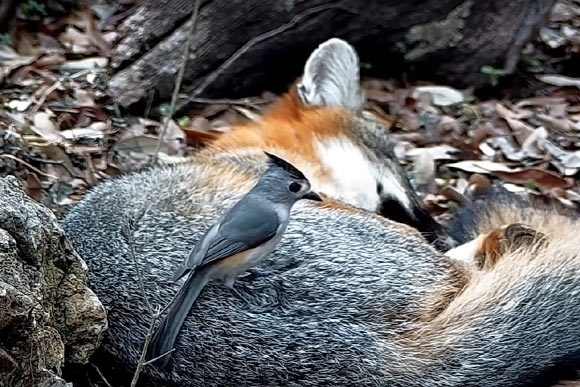
Some Birds Pluck Hair Directly from Live Mammals, Scientists Say
Researchers from the University of Illinois at Urbana-Champaign and the Universidade Federal do Rio Grande do Sul have observed several bird species exhibiting a behavior that the authors are terming kleptotrichy (from Greek ‘klepto-’ — to steal + ‘trich-’ — hair).
“Many species of titmice, chickadees and tits — all members of the bird family Paridae — are known to use hair or fur to line their nests,” said Professor Mark Hauber, a researcher at the University of Illinois Urbana-Champaign.
“The hair’s role in the nest is still debated, although it is more commonly used by birds nesting in temperate climates, so maintaining warmth in the nest is thought to be one advantage.”
“Scientists once assumed that birds with hair in their nests had collected it from the carcasses of dead mammals or found hair that had been shed into the environment,” said Professor Jeffrey Brawn, also from the University of Illinois Urbana-Champaign.
“But the titmouse I saw was plucking hair from a live animal. This was from a live raccoon with claws and teeth. And the raccoon didn’t seem to mind because it didn’t even wake up.”
The scientists found only 11 occurrences of kleptotrichy by six bird species in the peer-reviewed literature.
These reports included six observations of the tufted titmouse (Baeolophus bicolor) plucking hair from four mammal species including humans (Homo sapiens), three honeyeater species plucking hair from koalas (Phascolarctos cinereus) or humans, and two additional observations: red-winged starlings (Onycognathus morio) plucking hair from klipspringers (Oreotragus oreotragus) and american crows (Corvus brachyrhynchos) plucking hair from a domestic cow (Bos taurus).
“A YouTube search yielded many more cases,” Professor Hauber said.
“Sometimes the target animals were sleeping, and sometimes they were awake.”
“We know, of course, that birds use a variety of materials to line their nests. But why are these birds risking their lives to approach these mammals?”
“The behavior suggests that the benefit of lining its nest with hair outweighs the danger to the bird.”
It may be that the birds simply need the hair to insulate their nests, but the presence of mammal hair — and the associated odor of the mammal — could also deter nest predators like snakes or other birds.
“There’s a local species called the great crested flycatcher, which, like the titmouse, is a cavity nester, that actually puts shed snakeskins into its nest, possibly to deter predators,” Professor Brawn said.
“There are finches in Africa that put mammalian fecal material on top of their enclosed nests, presumably to confuse and thus keep predators away,” Professor Hauber added.
“The hair also may repel nest and nestling parasites, which are a common threat to chick survival, especially in cavity nests like those of titmice.”
Collectively, the YouTube videos show titmice — and in one case, a black-capped chickadee (Poecile atricapillus) — plucking hair from 47 humans, 45 dogs, three cats, three raccoons and a porcupine.
“Unexpected interactions such as these remind us that animals exhibit all types of interesting and often overlooked behaviors and highlight the importance of careful natural history observations to shed light on the intricacies of ecological communities,” said Dr. Henry Pollock, a postdoctoral researcher at the University of Illinois at Urbana-Champaign.
The team’s paper was published online in the journal Ecology.
